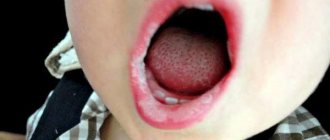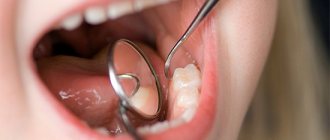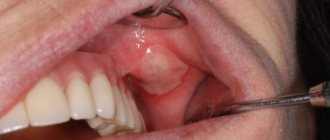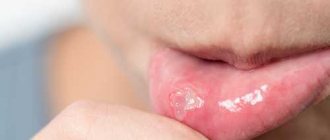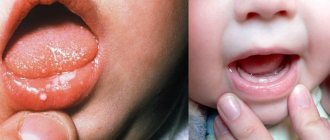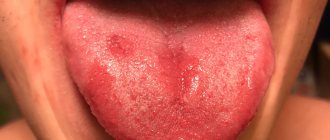Bubbles with yellowish contents on the mucous membrane of the cheeks, back of the tongue, and lips cause pain to the baby and are accompanied by drooling and low-grade fever. Active children become lethargic, sleep restlessly, and are capricious. This is how herpetic stomatitis manifests itself - damage to the mucous membrane provoked by the type I herpes virus. The disease is not dangerous if treated correctly. In the absence of medical supervision or self-medication, the symptoms disappear, but a chronic form may develop, laryngitis, and conjunctivitis may develop.
Herpetic stomatitis in children: general information
Children from six months of age to 5 years are most vulnerable to infection. By 6 months, the protective antibodies received from the mother are gradually eliminated, and one’s own immunity is still weak. The virus is transmitted from parents through licked nipples and spoons, and kisses.
Herpetic stomatitis in a 2-year-old child appears during the first active contacts with children. Infection occurs through toys and dirty hands. At 3–6 years old, the child goes to kindergarten, attends clubs and sections. Adaptation to a team, stress, psycho-emotional tension weaken the immune system. Therefore, acute herpetic stomatitis (AHS) in pediatric dentistry is the leader among inflammations of the oral cavity.
In addition to weak immunity, the development of stomatitis is facilitated by:
- Failure to comply with hygiene rules.
- Hypothermia and overheating.
- Damage to the mucous membrane.
- Past ENT diseases, ARVI.
- Poor diet and vitamin deficiency.
Acute herpetic stomatitis
Acute herpetic stomatitis in children develops between six months and three years of age. This happens because in the first months after birth, the baby’s innate antibodies disappear, making him vulnerable to infections.
There are factors that contribute to the appearance and development of acute herpetic stomatitis in children. This:
- change in climatic conditions (overheating or hypothermia of the body);
- various concomitant diseases that weaken the immune system;
- failure to comply with hygiene rules for oral care;
- neuropsychiatric disorders.
In cases where acute herpetic stomatitis in children is not treated, the virus remains in the body for life, causing periodic relapses. Thus, the disease becomes chronic, and it can be caused by colds, stress, injury to the mucous membranes of the mouth, allergies, and vitamin deficiency.
Symptoms of herpetic stomatitis
The severity of acute syndrome is determined by the combination of the severity of mucosal lesions and general symptoms (fever, headache, vomiting). With herpetic stomatitis, there is no transition from stage to stage - either immediately mild, severe, or moderate. In children, general symptoms prevail over local ones; even with minor inflammation of the mucous membrane, low-grade fever and weakness are observed.
Mild form of OGS. The rash is preceded by a rise in temperature to 37.5°C. After 1–2 days, catarrhal gingivitis develops (swelling, darkening, bleeding in the gingival margin). Salivation increases, and the submandibular lymph nodes may enlarge. Against the background of inflammation of the gums, bubbles (up to 3-5 pieces) appear in the mouth, which quickly open and turn into small ulcers with a white coating and reddened edges. Herpetic stomatitis on the tongue causes pain when talking, chewing, children refuse to eat. The rash appears once. After 1–2 days, the temperature returns to normal, swelling of the gums, pain and burning in the mouth decrease. Erosion heals without scars within 5–7 days.
Moderate degree of AHS. The onset of the disease is indicated by a slight increase in temperature, physical malaise, soreness and hardening of the submandibular and cervical lymph nodes. After a day or two, the part of the gum surrounding the teeth swells, turns red and aches, and the temperature rises to 38℃. On the reddened mucous membrane of the mouth and the skin of the perioral area, blisters appear in the amount of 5–15 pieces; they can unite into large painful ulcers with pink outlines and reappear. How long it takes for a child to get herpetic stomatitis depends on immunity, timeliness and effectiveness of treatment. Typically, the peak period of the disease lasts 7–10 days. Without adequate treatment, a herpetic infection can spread to the conjunctiva of the eyes, and ulcerative gingivitis with bleeding erosions, damage to the oropharynx, and deformation of the gingival papillae can develop.
Severe form of OHS. It develops rarely, in most cases in children with immunodeficiency. Already at the beginning of the disease, the lymph nodes in the neck and under the jaw become inflamed, and the temperature rises to 40℃. The swollen mucous membrane bleeds; after a day, bubbles form in the oral cavity, near the lips. New rashes appear repeatedly, you can see a vesicular rash at different stages of healing, merging erosions. Recovery is long (14 days or more), herpetic stomatitis can become recurrent and periodically worsen.
If you notice a rash in your child’s mouth or lips, sign up for a consultation. Our pediatric dentists and periodontist will find a common language with the little patient and quickly alleviate the condition.
Acute herpetic stomatitis in children
There are 5 periods of development of acute herpetic stomatitis in children:
- incubatory
- premonitory
- development of the disease
- extinction
- clinical recovery
The disease is also differentiated by severity. In a mild form, the child has no external manifestations of intoxication, and the prodromal period is clinically absent. The onset of the disease is sudden, the temperature rises to 37-37.5° C. The general condition of the child is very satisfactory. In the oral cavity, slight swelling and hyperemia are observed, mainly affecting the gums. Most often, lesion elements (single or located in groups) are observed in the mouth; there are usually no more than six of them. The period of development of the disease lasts 1-2 days. Over the course of 1-2 days, the shade of the elements becomes reminiscent of marble, their edges and center are blurred. The pain gradually goes away. The elements are epithelialized (covered with epithelium), but after this, the phenomena of catarrhal gingivitis described above persist for another 2-3 days. Changes in the blood are not observed in mild forms of acute herpetic stomatitis. Toward the end of the disease, slight lymphocytosis may be detected.
The moderate form of the disease in question is distinguished by clearly defined symptoms of toxicosis and damage to the oral mucosa during all periods of the disease. Even before symptoms appear, the child’s well-being deteriorates, loss of appetite and weakness are observed. Symptoms of acute respiratory disease or catarrhal tonsillitis are likely. Enlargement of the submandibular lymph nodes and their pain are recorded. Body temperature rises to 37-37.5° C.
the phase of catarrhal inflammation begins , in which the temperature rises to 38-39 ° C. The following symptoms appear:
- nausea
- pale skin
- headache
- hyperemia and swelling of the mucous membrane increases
- 10-25 elements of lesions in the oral cavity
- saliva becomes viscous, viscous
- salivation increases
- bleeding gums
- pronounced gingivitis
The rash often appears in several stages. After the first rash, the body temperature usually drops to 37-37.5 ° C. But when the next rash occurs, the temperature rises again. Sleep is disturbed, and symptoms of secondary toxicosis often increase. A blood test shows an ESR of up to 20 mm/hour, more often leukopenia, and slight leukocytosis is also possible.
The period of extinction of the disease can vary in duration, which depends on the ability of the child’s body to resist the disease, on the presence of teeth with caries and decayed teeth, as well as on the effectiveness of the prescribed treatment. The elements of the rash merge, then ulcerate (turn into ulcers). Then they become covered with epithelium over the course of 4 to 5 days.
The moderate form of acute herpetic stomatitis in children differs from the mild form by a smaller amount of interferon, as well as a lower content of lysozyme in saliva. A severe form of acute herpetic stomatitis in a child is very rare. During the prodromal period (before the onset of symptoms of the disease), the following signs appear:
- adynamia
- apathy
- musculocutaneous hyperesthesia
- headache
- arthralgia
- symptoms of damage to the cardiovascular system (not in all cases)
The period of development of the disease is characterized by an increase in temperature to 39-40°C. The expression on the child’s lips is mournful, his eyes are sunken in suffering. There may be a cough, a slight runny nose, dry and bright lips. Swelling of the oral mucosa, its hyperemia and pronounced gingivitis are characteristic.
After 1-2 days, a large number of rashes appear in the mouth - their number can reach up to 25. They can be not only in the mouth, but also in the oral area, on the conjunctiva of the eyes, the skin of the eyelids, fingers, etc. At the peak of the disease, rashes appear in there are about 100 in the mouth. Catarrhal gingivitis turns into an ulcerative-necrotic form. There is a sharp putrid taste coming from the mouth. The child has a lot of saliva, there is an admixture of blood in it. Inflammation of the respiratory tract, nasal mucosa and eyes is further aggravated. In severe cases, children are almost always hospitalized.
In severe forms of acute herpetic stomatitis in children, a band shift to the left, leukopenia, eosinophilia, young forms of neutrophils, and single plasma cells are recorded in the blood. Saliva is acidic, but alkalinity may gradually increase. Interferon is usually absent.
Treatment of herpetic stomatitis at the “Family Dentist”
Therapy for OHS is complex; in mild to moderate cases, it is carried out at home. The dentist prescribes medications, gives recommendations on nutrition and oral hygiene. The cost of an appointment in our clinic is from 10 rubles.
When herpetic stomatitis is diagnosed in children, the treatment regimen includes:
- Diet. Food should be liquid or semi-liquid (mashed soups, vegetable purees, cereals, jelly, yoghurts, minced meat and fish) at a comfortable temperature. In case of extensive erosions, it is advisable to feed the baby liquid food through a tube.
- Prevention of dehydration. Water balance is maintained with dried fruit compotes, broths, plain water, and a weak rosehip decoction.
- Oral hygiene. To prevent the development of a secondary infection, teeth should be cleaned with a soft brush without paste, and the mucous membrane should be treated with a swab and a warm antiseptic solution. You should rinse your mouth every time after eating.
- Local, general therapy. The drugs are prescribed by the dentist, taking into account the severity of the acute syndrome.
Mild degree. Ulcerations of the mucous membrane are treated 3-4 times a day with a cotton pad or bandage soaked in a solution of chlorhexidine 0.05% or miramistin. If necessary, the doctor prescribes an antiviral ointment. If there is no risk of seizures, antipyretic drugs are not prescribed.
Moderate degree. At the height of herpetic stomatitis, treatment with local antiseptic solutions is supplemented with tableted antiherpetic drugs, if the rash does not begin to dry out on the 2nd–3rd day. Medicines have an effect on the entire body, therefore they are taken only as prescribed by a doctor. The mucous membrane after a viral infection is restored with healing agents with vitamins A, E, and sea buckthorn oil. To reduce pain, lidocaine gel is applied to the mucous membrane 20 minutes before meals.
Severe degree. The dentist refers you to the hospital, treatment is carried out with injectable drugs, immunostimulants, and physiotherapy is prescribed.
To make an appointment at the “Family Dentist” in Minsk, fill out the form or call. You don't have to stand in line with a sick child.
Herpetic stomatitis: symptoms
Taking into account the nature of the disease and the characteristics of its course in the patient, two forms are distinguished: acute and chronic recurrent. In the first form, the symptoms are very pronounced, the disease is more severe, and all signs usually disappear completely after adequate treatment. In the chronic relapsing form, the symptoms are less pronounced, long periods of remission (“rest”) are observed with periodic relapses.
Acute herpetic stomatitis most often occurs in young children and adolescents. In adults, this disease occurs much less frequently, since their immune system works better and more actively than children's. This disease is also called herpetic aphthous stomatitis, due to specific aphthous ulcers in the patient’s mouth. The main signs of stomatitis in children and adults are:
- Swelling and redness of the mucous membranes of the mouth.
- Single or grouped vesicles with serous contents in small areas of the mucous membrane. When such bubbles collapse, erosive spots with a whitish coating in the center are formed. Such erosions are very similar to true aphthae, so the disease was previously classified as herpetic aphthous stomatitis, although in fact we are talking about two different types of the same disease.
- Pain when eating and drinking, burning and itching in the mouth.
- Weakness, fever, nausea, possibly vomiting and diarrhea. These symptoms almost do not appear with mild degrees of the disease; with moderate and severe degrees they are quite pronounced.
What the oral cavity looks like with herpetic stomatitis can be seen in the photo.
Causes of stomatitis in children
There are many reasons why childhood stomatitis can occur. Here are the following:
- Fungus, in particular the genus Candida;
- Viruses;
- Mechanical injuries (for example, an overly hard nipple, uncooled food can cause damage);
- Protracted illnesses, exhausted immune system;
- Lack of systematic oral care;
- Failure to follow basic rules and recommendations for brushing teeth;
- Unwashed hands.




